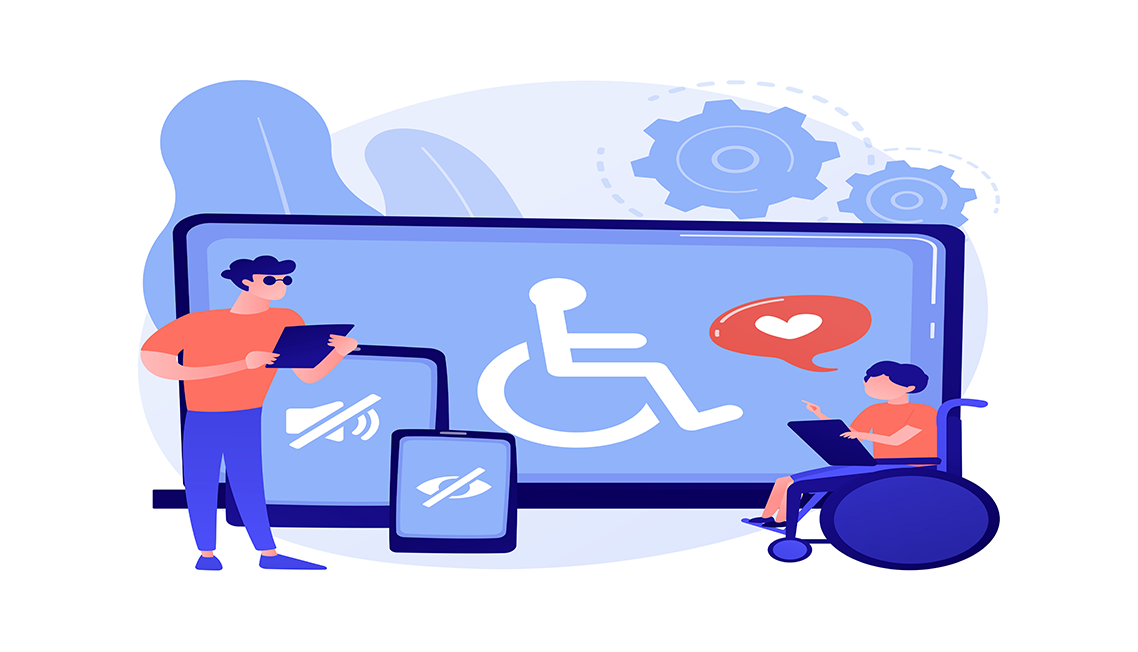-
- Tag
- Technology
The importance of accessibility for online content of a business.
If your business deploys digital assets such as websites, portals, apps, and promotions, you should understand why and how to comply with the Web Content Accessibility Guidelines. Commonly called WCAG, these tenets were developed by the World Wide Web Consortium (W3C) as the industry standard for digital accessibility for those with disabilities. The group has nearly 440 members and develops standards for computer languages like CSS3 and HTML.
Most accessibility regulations worldwide use WCAG for their policies and laws. These guidelines can be applied across all current and future digital technologies. In simple terms, WCAG aims to keep the entire internet accessible for everyone now and as online communication evolves.
What does WCAG cover?
WCAG establishes web accessibility standards for various functional needs, including updates that facilitate digital access for those who face challenges in these areas:
Attention | Auditory and hearing | Executive function | Literacy, and language | Memory and focus | Mental health | Mobility and motor | Cognitive, physical, and sensory interactions | Speech| Visual
Levels of WCAG compliance and what it means for a business
WCAG establishes three levels of conformance: A, AA, and AAA, each with different criteria for successful implementation. Level A, with 25 criteria, refers to the lowest level of conformance (minimum), and Level AAA is the highest (maximum) with 61 required criteria.
A represents the minimum accessibility standards digital content should meet to avoid discriminating against audience members with disabilities. Level AA sites, which must meet 35 criteria, are designed for maximum accessibility and meet legal compliance standards. Federal, state, and local government agencies and other public service sites should ideally achieve AAA compliance.
A quick history of WCAG
WCAG was introduced in 1999 to provide guidance around online accessibility for people with mental disabilities, mobility issues that make using a mouse or keyboard challenging, deafness, impaired vision, etc. The most recent major update, WCAG 2.1, came out in June 2018 with 17 new success criteria improving coverage for cognitive disabilities, low vision disabilities, and mobile accessibility.
The next update to the guidelines, WCAG 3.0, is available now as a working draft and will be finalized in 2023. This new version will address the influx of mobile and wearable tech devices and digital voice assistants like Siri and Alexa and cover over 50 functional needs that make it possible for people with disabilities to use the full extent of the internet.
WCAG 3.0 extends to rather than replaces WCAG 2.1, and your company need not change its compliance strategy if your digital content already conforms to WCAG 2.1. For compliance purposes, many government agencies in the U.S. will continue to require adherence to 2.1 or 2.0 rather than adopting 3.0 immediately.
Should your business comply with WCAG?
Certain organizations must conform to WCAG under the Americans With Disabilities Act. This portion of the federal law applies to schools, colleges, universities, health care institutions, financial institutions, and state and local government offices. Organizations in these categories can receive a $75,000 fine for a single ADA violation and $150,000 for subsequent violations.
How Title III of ADA ties into WCAG
Title III of the ADA governs website accessibility. According to the Department of Justice, this part of the act applies not just to physical locations open to the public but also to publicly available digital locations (websites and apps). Under this title, these locations must be accessible to all individuals and groups. In other words, if your company has digital content accessible online, you must comply with accessibility standards.
In addition, Section 508 of the Rehabilitation Act of 1998 requires all digital information published by federal agencies to be accessible. Specifically, individuals with disabilities must be able to obtain comparable access to publicly available federal information. Section 508 and Title III have established compliance requirements based on the AA level of WCAG 2.0.
The potential for discrimination claims
Even if your company doesn’t need WCAG conformance according to ADA, you could be subject to a discrimination lawsuit if your business website lacks accessibility for individuals with disabilities. Digital accessibility lawsuits in this category (Title III claims) increased by approximately 50% from 2018 to 2020, according to data published by UsableNet.
Given this information, most organizations aim for mid-range conformance at level AA. This strategy provides meaningful and achievable accessibility goals with limited digital design and development disruption. If your company does not have specific compliance requirements under ADA, either A or AA level compliance can shield you from legal action based on digital discrimination.
What are the benefits of WCAG beyond compliance?
Legal compliance isn’t the only advantage of adding accessible features to your company’s digital content. These are some of the other benefits you can realize with this initiative.
Improved SEO ranking
Many criteria Google uses to rank websites overlap with best practices for digital accessibility. As your company addresses WCAG compliance, you’re also engaging in search engine optimization (SEO). The better your site’s SEO, the more customers you’ll attract to your business through organic searches. Common website updates that boost both SEO and WCAG compliance include:
- An organized layout that proceeds logically from one topic to the next
- Alternative suggestions provided in response to user input errors
- Header code that indicates the site’s language
- Audio and video text transcripts and alt tags (and alt tags for images)
Enhanced user experience
Even individuals without disabilities are more likely to consume your online content if they can take advantage of accessibility options. When accessibility improves to address functional needs, the user experience improves for your entire audience. A parent with unaffected hearing might use closed captions when watching a video next to a sleeping child. Audio instructions are more convenient for hands-on instructions, such as trying a new recipe or building furniture.
Bolstered brand image
Accessible online content also elevates the profile and reputation of your brand. Most people want to work with companies that share their values. Pursuing inclusive initiatives such as WCAG compliance illustrates the organization’s commitment to avoiding discrimination and promoting open access.
Expanded reach and revenue
According to the Centers for Disease Control and Prevention, 61 million Americans live with a disability. This number represents more than a quarter of all U.S. adults. Preventing these individuals from accessing your business website creates a legal and moral issue and limits your potential revenue by automatically leaving out a large portion of your prospective audience.
Checking for WCAG conformance
While complete conformance with the comprehensive WCAG standards represents a challenge for many business owners, taking small initial steps can significantly impact the accessibility of your digital content.
You can start by assessing your website or online assets for basic WCAG components by measuring them against POUR standards (Perceivable, Operable, Understandable & Robust), documenting the gaps identified, and prioritizing the steps to remediate the same. For more details, look up our blog –How can my company achieve and maintain WCAG compliance?.
Digital presence is the new storefront of a business
Don’t wait until the release of WCAG 3.0 to start work on digital accessibility compliance. Most components of the new version remain aligned with WCAG 2.1’s recommendations. These include best practices for audio, podcasts, video, image presentations, forms, digital signatures, focus state, links, navigation, frames, tables, maps, graphs, colors, fonts, layout, infographics, organization, and structure.
Connect with our team of technical & accessibility experts to understand how we can help your business reach and keep conformance with WCAG standards.
Contact Us
Reach out today to schedule a discussion with an iBridge team member to learn how we can help your business conform with WCAG standards.










